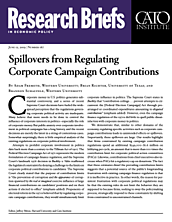Attempts to prohibit corporate involvement in politics date back more than a century to the Tillman Act of 1907. The Federal Election Campaign Act of 1971 represents the modern formulation of campaign finance regulation, and the Supreme Court’s landmark 1976 decision in Buckley v. Valeo reaffirmed the legislated constraints by denying a challenge to the limits on corporate political contributions to candidates. The Supreme Court clearly stated that the purpose of contribution limits is “the prevention of corruption and the appearance of corruption spawned by the real or imagined coercive influence of large financial contributions on candidates’ positions and on their actions if elected to office” (emphasis added). Proponents of electoral reform in the 1970s believed that by regulating corporate campaign contributions, they would simultaneously limit corporate influence in politics. The Supreme Court states in Buckley that “contribution ceilings … prevent attempts to circumvent the [Federal Election Campaign] Act through prearranged or coordinated expenditures amounting to disguised contributions” (emphasis added). However, even the campaign finance regulation of the 1970s did little to quell public dissatisfaction with corporate money in politics.
We demonstrate that, similar to other domains of the economy, regulating specific activities such as corporate campaign contributions leads to unintended effects or spillovers. Importantly, these spillovers are large. Our results highlight that firms constrained by existing campaign contribution regulations spend an additional $549,000–$1.6 million on lobbying per cycle, an amount that is more than 100 times the contribution limit for corporate political action committees (PACs). Likewise, contributions from chief executives also increase when PACs hit a regulatory cap on donations. The fact that these estimates dwarf the prevailing contribution limits suggests that a potential source of the public’s longstanding frustration with existing campaign finance regulation is that it is ineffective in practice. In other words, the reason for persistent frustration with corporate political regulations may be that the existing rules do not limit the behavior they are supposed to because firms, seeking to sway the policymaking process, strategically respond to these constraints by shifting from constrained to unconstrained channels.
To evaluate the degree to which these spillovers arise, we exploit the relationship between statutory campaign contribution limits on firms’ PACs and alternative modes of political activity. Marrying information on corporate lobbying and campaign contributions, our data include more than 6.8 million firm-candidate observations linked across nine election cycles. This enables us to exploit the institutional details of the United States’ campaign finance laws, isolate a firm’s marginal campaign contribution, and employ rich time-varying fixed effects to control for an extensive assortment of unobserved factors. In separate models we apply a regression discontinuity design. Specifically, we measure the response of CEO contributions and lobbying expenditures when a firm’s PAC makes the maximum allowable political contribution to a particular candidate relative to other candidates that receive below-limit contributions from the same firm. Intuitively, it would appear there is an obvious omitted variable in this analysis: firm political strategy.
The benefit of having a large data set and a clearly defined regulatory threshold is that we are able to mitigate bias caused by this variable being omitted as long as two assumptions hold. First, in our models examining the relationship between CEO donations and the firm’s PAC contributions, we allow both the political views of candidates and overall firm strategy to vary over time. We assume, however, that firm-by-candidate-by-electioncycle factors are orthogonal to CEO contributions. Stated differently, firms cannot strategically target specific election candidates within an election cycle in a manner that is positively correlated with CEO contributions.
Although we believe that this condition is broadly plausible, we take an additional step in our robustness analysis: we embed the firm-cycle and candidate-cycle fixed effects models within a difference-in-difference specification where we examine the relationship between a CEO and the PAC’s contributions before and after the Bipartisan Campaign Finance Act of 2002. Next, to avoid omitted variable problems for our lobbying models, we assume that in the absence of campaign finance regulation, contributions will increase smoothly around the limiting threshold. In other words, without the Federal Election Commission (FEC) regulations, we would not expect to observe a large discrete jump in a firm’s lobbying expenditures, which we find as its PAC transitions from making, for example, a $9,900 donation, compared with the limiting $10,000 donation. This smoothness assumption is tested for alternative variables such as advertising, R&D, and dividend expenditures, and it appears to hold for these variables but not for lobbying. As such, we view this smoothness test as reasonable. Finally, we probe the sensitivity of our models via several placebo tests. Overall, our main conclusion is that statutory limits on corporate PACs are effectively nonbinding and that the spillovers can be economically meaningful.
Even as advocates call for stricter regulation of corporate political activity in the aftermath of Citizens United v. FEC and SpeechNOW.org v. FEC — two Supreme Court decisions that created new opportunities for corporate money in politics — they appear to underemphasize an important point: many of the political activities in which companies engage are challenging to observe and hence difficult to regulate. Documenting the unintended consequences of existing campaign finance regulation on observable activities, such as lobbying, therefore provides valuable perspective. This is especially true as we demonstrate that the spillovers from imperfect regulation can often be larger than the initial problem that the rules were attempting to remedy. Magnitudes become important, especially if corporate political activity is increasingly hidden from view. If the spillover effects are large between lobbying and campaign contribution, they may be equally important along margins that are more difficult to control (i.e., independent expenditures and targeted philanthropic giving).
NOTE:
This research brief is based on Adam Fremeth, Brian Richter, and Brandon Schaufele, “Spillovers from Regulating Corporate Campaign Contributions,” Journal of Regulatory Economics 52, no. 3 (December 2018): 244–65, https://link.springer.com/article/10.1007/s11149-018‑9369‑7.

